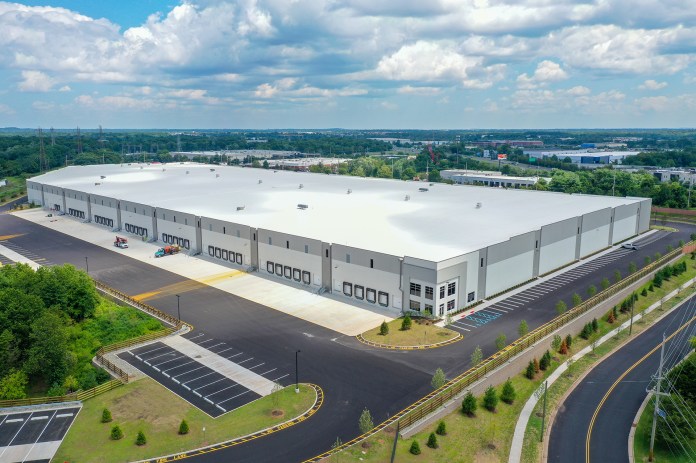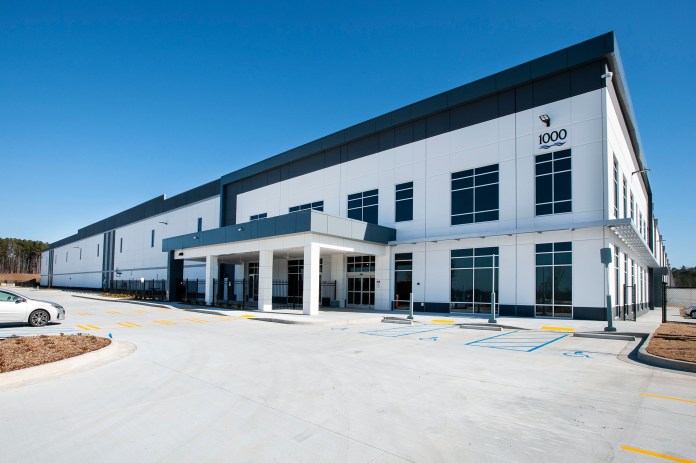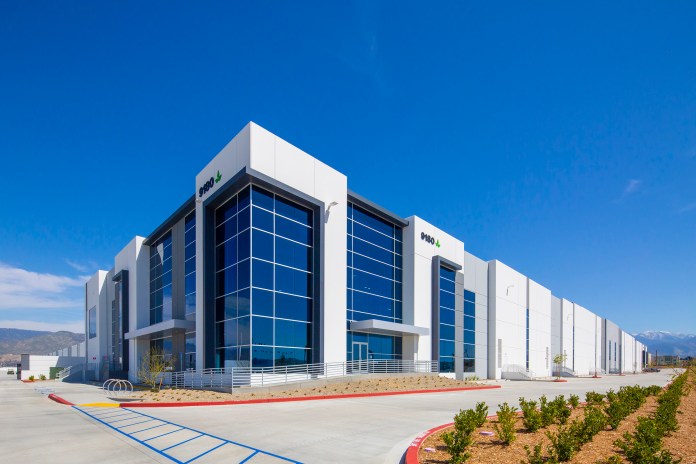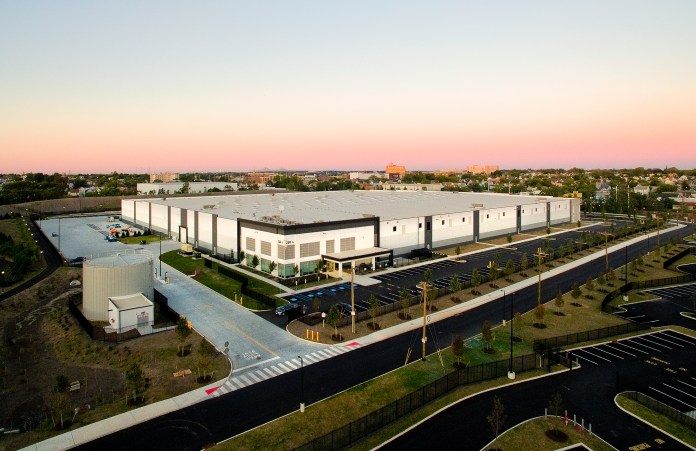ESG Practices in the Industrial Sector With Duke Realty
Vice President of Corporate Responsibility Megan Basore on the company’s efforts to create a cleaner environment.
Duke Realty Corp. owns and manages more than 160 million square feet of logistics space across 19 U.S. markets. The REIT took advantage of the pandemic-triggered boom of the industrial sector, but it did so in a responsible and eco-centric way, even before the onset of the health crisis. Since 2019, the company has been pursuing LEED certification on all of its new development projects.
Megan Basore, vice president of corporate responsibility at Duke, talked to Commercial Property Executive about the company’s environmentally friendly methods and its goal to reach carbon neutrality by 2025.
Why is sustainability important for the industrial sector and what have been the biggest changes in the shift from a sustainability strategy to an ESG strategy?
Basore: According to data from the U.S. Department of Energy, commercial buildings account for 35 percent of electricity consumed in the U.S. and 16 percent of all U.S. carbon dioxide emissions. So, developing more efficient buildings and finding ways to reduce carbon emissions are critical to creating a cleaner environment.
As an industrial developer, we are constantly looking for ways to build sustainably—such as developing LEED-certified buildings, establishing smart building features to help tenants operate more efficiently and committing to carbon neutrality in our operations by 2025.
We haven’t shifted but rather evolved the language we use to take a more holistic view of our company’s impact on our stakeholders. Our ESG strategy focuses on environmental stewardship, social responsibility and responsible corporate governance. However, each of these components separately have been part of our culture for many years.
Analyzing the ESG components individually, how will your strategy unfold this year?
Basore: For environmental, we will focus on implementing strategies to achieve our carbon neutrality goal and exploring opportunities to offer renewable energy solutions to our tenants.
In terms of social, we will promote associate well-being, and champion diversity, equity and inclusion. We will continue our culture of giving by volunteering our time and dollars to important causes in the communities we serve.
In terms of governance, transparency, adherence to our code of conduct and requiring our vendors to do the same will be key focuses this year.
Tell us about Duke’s ESG strategy during the pandemic. For example, in 2020, you conducted the first materiality assessment. What did you learn?

Megan Basore, Vice President of Corporate Responsibility, Duke Realty Corp. Image courtesy of Duke Realty Corp.
Basore: In early 2020, I stepped into the role of vice president of corporate responsibility. Our strategy during the pandemic was a combination of creating a solid foundation for future growth, as well as focusing on our people.
We continued to focus on developing efficient buildings, supporting our people and the communities where we do business, and operating with the highest ethical standards. It was a great opportunity to learn more about what we were already doing and to share best practices. It also helped create new goals that were aligned with our stakeholders’ standards and expectations.
One of the biggest steps to this process was taking the time to complete our first materiality assessment to gain insights into the most important ESG aspects on a granular and global level. We started the materiality assessment at the end of 2020 and completed it mid-year 2021.
Some of our biggest takeaways included the huge emphasis on our people and their development, retention and job satisfaction, as well as the impact that our buildings have on our environment. One of the more difficult projects was to identify and transition to a more robust approach to energy data management. Without a better understanding of where we are today, it is difficult to measure the impact of our change in the future.
Our focus in 2022 will be working toward achieving carbon neutrality, furthering our renewable energy initiatives and expanding our diversity, equity and inclusion efforts.
In the first year of the pandemic, Duke partnered with Solar Landscape. Can you tell us more about the venture? Are you considering additional such partnerships?
Basore: Solar Landscape has been a great partner for us. We worked with Solar Landscape to install solar panels on the rooftops of four Duke Realty facilities as part of New Jersey’s Community Solar Energy Pilot Program. The project generates nearly 11 megawatts of solar energy that powers 1,800 New Jersey households with 51 percent of the energy going to low- and moderate-income households. We are proud that this is making solar energy accessible to a community we serve. We hope other businesses will replicate this initiative.
Although we do not have energy savings data yet, a major impact of this project was job creation. As part of the pilot program, Solar Landscape trained more than 100 solar installers, partnering with community-based organizations across New Jersey to integrate workforce development and education into the projects.
Investigating renewable energy solutions for our tenants is one of our strategies that will help us achieve carbon neutrality. We will continue to look for ways to partner with companies such as Solar Landscape. We recently hired a renewable energy manager to move this and other programs forward.
What makes a successful ESG strategy and how do you measure success in an ESG strategy? What key measures should take center stage?
Basore: Teamwork. ESG is part of our company and is integrated into how we do business. We need the entire team to execute our strategy. Success is measured by accomplishing our goals. We set forth short- and long-term goals for the company, and we work together to achieve them.
Key measures of focus will be progress on our goals—carbon neutrality, access to new renewable energy opportunities and continued growth of our DEI efforts.
What are Duke Realty Corp.’s plans related to decarbonization, water conservation, waste management and transportation upgrades?
Basore: Our first step is to work with our tenants to assess how our facilities across the country are performing. We need our tenants’ help to learn how they are using energy, water and transportation at our facilities. What we can control on our own is developing highly efficient buildings, making efficiency upgrades to our existing buildings where appropriate and looking at renewable energy sources.
Currently, we integrate energy usage reduction measures on all new developments, incorporating LEED certification requirements and applicable aspects of our own sustainability policies and programs. These measures include energy modeling, high efficiency equipment—HVAC and lighting—and climate zone appropriate design factors. We have an ongoing lighting retrofit program, replacing outdated light fixtures with LED fixtures.
READ ALSO: Buildings of Tomorrow: Future Warehouses
We integrate water reduction measures on all new developments and renovations, incorporating LEED water-efficiency-credit criteria or applicable aspects of our own sustainability policies/programs. These measures include the use of WaterSense fixtures for all domestic usage, xeriscaping to minimize or eliminate the need for irrigation, and water usage monitoring, where available and appropriate.
It is imperative to seek innovation and drive change for the future. We are focused on continuing to find and test new technologies and ideas so that we can continue to build better buildings, and make the best decisions regarding upgrades to our existing facilities.
Last year, you had 11 logistics facilities certified to different LEED levels. Did you reach $2 billion in LEED development by the end of 2021, as you had planned?
Basore: Sustainable development continues to be an integral component of Duke Realty’s corporate responsibility program. We were one of the first U.S. industrial REITs to set a goal to develop all LEED-certified buildings. We felt it was the right thing to do given how much construction and commercial real estate contribute to energy consumption and carbon dioxide emissions.
We did reach $2 billion in LEED development by year-end 2021. In fact, we have invested $2.3 billion in LEED development since 2019 and can now boast 34 facilities—totaling 16,680,270 square feet of space—as LEED certified. When factoring in projects in the process of receiving certification, LEED buildings represent 24 percent of our net operating income.
In April of 2021, we were awarded the LEED v4 for Core and Shell Volume Program Precertification Level of Gold to further our commitment to operating responsibly. This provides a streamlined solution for achieving certification on future projects based on the approval of a building prototype.
For your corporate headquarters in Indianapolis, you pursued LEED Silver and Fitwel certifications. What measures did you take to apply for these awards?
Basore: When we decided to build our new headquarters, we knew it was important to practice what we preach. Our commitment to ESG starts at home and we took a thoughtful approach to make our headquarters a safe place for our associates, while promoting collaboration, community connectivity and efficiency. Our space reflects our company culture and incorporates amenities that encourage our associates’ health and well-being.
We anticipate obtaining LEED Silver certification for our headquarters soon. We earned a Fitwel Certification 2-Star rating for our leadership in health-promoting design and management that support the physical, mental and social health of the building’s occupants, which include:
- An indoor air quality policy that includes increased circulation and a tobacco/smoke-free environment;
- Walkability and proximity to community amenities, as well as multiple transit opportunities for building occupants;
- Outdoor amenities including walking trails and a restorative garden;
- Workspaces with abundant natural daylight, views of nature and active workstations;
- Collaborative shared spaces and personal health breakout rooms;
- Design strategies promoting physical activity through signage, accessible and inviting stairways and an on-site fitness center;
- Informative health programs for building occupants;
- A comprehensive emergency preparedness plan.
Tell us more about Duke’s green bond offerings.
Basore: Duke Realty became the first industrial real estate investment trust to source funds solely for environmentally friendly development in the U.S., with the issuance of a $400 million green bond in 2019. In total, we have completed approximately $1.35 billion in green bond offerings which we will invest entirely in green projects.
We issued two green bonds in 2021, including an issuance of $500 million of senior unsecured notes in November 2021 and an issuance of $450 million of senior unsecured notes in January 2021. The net proceeds from these offerings will be used to finance future or refinance recently completed “eligible green projects.” These projects may include green buildings, energy-efficiency projects, sustainable water and wastewater management systems, renewable energy projects, clean transportation solutions, and pollution prevention and control.
What’s ahead for Duke Realty in 2022?
Basore: We will continue to focus on the coastal tier-one markets, while keeping an eye on infill opportunities. Our leasing prospects and development pipeline are very robust, and we are optimistic about continued new development starts.
At Duke Realty, we realize the impact we have on the communities we serve and the world in which we live. Duke Realty is committed to thoughtful, sustainable practices—environmental stewardship, social responsibility and responsible corporate governance. This will remain our focus.












You must be logged in to post a comment.